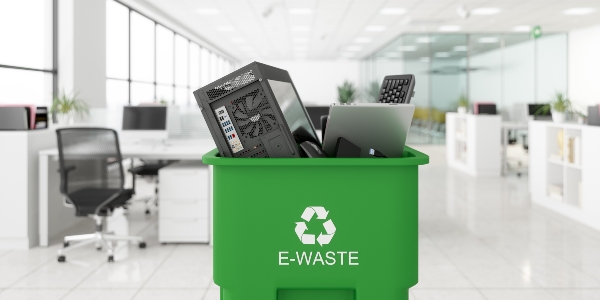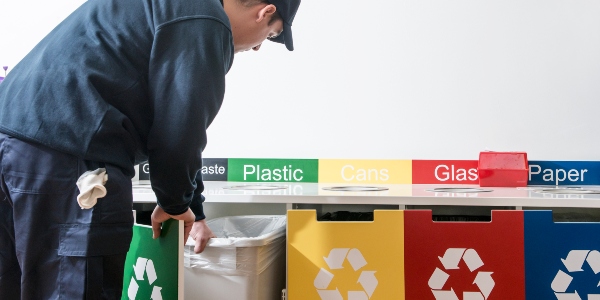Five practical tips that office-based businesses can adopt to reduce their environmental footprint.
1. Procurement 2. Conserve electricity 3. Repurpose & recycle 4. Waste Audit 5. Go digital
Have you been considering creating a more environmentally responsible workplace? A place that promotes reduction in waste - be it energy or rubbish? Reuse, refurbish and practice a more sustainable lifestyle.
Sustainability at the workplace might sound like a daunting and expensive task, but it is rather a collective effort taking baby steps towards making small and environmentally conscious choices.
People around the globe are becoming increasingly aware of the perils of climate change and seeking to reduce their environmental impact.
According to the Kantar Better Futures Report 2022, 66% of people across 20 markets believe it is essential for brands to be “committed to making our society better.”
OfficeMax has committed to improving our social impact and reducing environmental impact through developing and implementing our Sustainability Strategy.
We are progressing our strategy through a range of initiatives, including opting for a low-emission fleet, including forklifts, installing solar panels to power our Auckland distribution centre, partnering with charitable organisations to redirect and repurpose unwanted furniture stock for a second life and much more.
Sustainability Specialist at OfficeMax, Emma Coote, says that businesses in New Zealand – especially small and medium - play a vital role in contributing towards a more sustainable world.
“Businesses can take small but manageable steps to make their workplaces more sustainable. Reducing waste, cutting carbon emissions, and contributing to local communities will help reduce negative environmental and social impacts.”
Emma has over two and a half decades of experience working as a Sustainability and Environmental Lead across Healthcare, Aviation, and Food Industries in New Zealand and the United Kingdom.
Emma suggests five practical tips that office-based businesses can adopt to reduce their environmental footprint.
1. Procurement:
The first element of sustainability is to be conscious of what you purchase - understand its environmental and social impacts. Start at the top and make sensible procurement decisions for the workplace – it could save dollars and reduce social and environmental impact.
- Purchase locally made wherever possible. It is great for our communities and reduces the carbon footprint of a product. Look out for social enterprises and indigenous suppliers to maximise the social benefit.
- Be mindful of not just the function but the product’s lifecycle. Purchase good quality and sustainable products with greater shelf life and possible reuse options.
- Check if the products are ethically made and sourced. Do the suppliers have good human rights performances, such as having Fairtrade certification? Our website enables customers to use our EcoMax function to filter for the sustainable attributes of products and suppliers.
- Ensure employees know the procurement objectives of your organisation and buy from approved suppliers only.
- Think about the way you place orders for items you buy on a regular basis. Small, frequent orders are likely to have higher freight-related emissions than larger orders made less frequently.
2. Conserve electricity:
Our offices and everything within them are primarily powered by electricity. Whilst we can be proud of our largely renewable energy base in New Zealand, it is still important to conserve power. Electricity production and consumption contribute immensely to carbon emissions and pollution in our atmosphere.
- AC/Heating units: Create a consistent setting and avoid extra power consumption due to constant changes in temperature settings. Make sure your units are regularly maintained.
- Energy-efficient devices: Use energy-efficient products - LED bulbs, high energy-rated appliances such as microwaves, dishwashers, table fans etc. Where practical, use sensor lights that are activated when people are present.
- Stop snooze, switch off: If not in use, switch it off – lights, desktop computers, monitors, laptops, printers, laminators etc. Unplug chargers when not in use (mobile, laptop, smartwatch etc.). Devices in sleep mode or idly plugged into an outlet still consume energy.
- Service equipment regularly: Unserviced equipment soaks up energy and can also be a fire hazard.
- Make the most of natural lighting. It’s sustainable and free!
- Engage with staff on the benefits of efficient energy consumption.

3. Repurpose & recycle:
One of the best ways to reduce waste is to repurpose items that are not required. Find a local e-waste recycler and set up a process for collection or drop-off. Note that this may incur some costs. If items are not at their end-of-life, donate them to a local charity that can redirect them to schools, aged care, health centres, Lions Clubs, Red Cross etc.
OfficeMax can help our customers repurpose unwanted items by redirecting them via All Heart NZ Charitable Trust. We also donate dated stock to Auckland City Mission and Mercy Hospice for a second life.

4. Waste Audit:
Do a waste audit of the workplace – determine how much waste is generated from each area and if it can be cut down by trying alternative options.
- Kitchen or breakout area: Check if the waste is disposed of properly. For example, ensure that recyclable items, organic-composted waste, and landfill items are in their respective bins. Have signage well placed on or near bins that clearly show what goes where.
- Avoid single-use items: Use ceramic coffee cups and travel mugs instead of single-use paper-based coffee cups with plastic lids. Similarly, pick reusable lunch boxes and cutlery instead of plastic ones to cut down on waste going to landfill.
- Remove desk bins: Replace desk bins with an eco-paper recycling cube (100 cubic mm) that discourages large rubbish accumulation and helps reduce waste.
- Packaging boxes: Try reusing the cardboard boxes for storage and break unused boxes down properly when recycling.
Check out our Waste Audit Template for a monthly waste audit.

5. Go digital:
- Use e-notebook apps such as OneNote, Trello, and Google Workspace on your devices instead of physical notebooks. If using notebooks, procure FSC-certified and recycled items and stationery.
- Get refillable toner printers. Consider managed print services as they will complete a companywide printer audit that will provide a report on your consumption print/copy consumption, usage, and energy efficiency.

- Print only if necessary. Try using recycled or carbon-neutral paper and double-sided or booklet printing to reduce paper consumption. Print in greyscale instead of coloured ink, as it reduces consumption and is inexpensive.
- Put wastepaper into assigned recycling bins or shred it if it contains sensitive material.
Sustainability in a workplace is a combination of many micro activities that can result in significant improvements and achieve long-term environmental and financial goals.